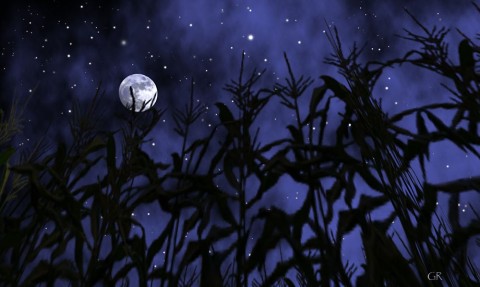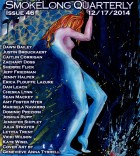Some of us leave our bones behind.
That’s what Tessa said the night she and I absconded into the cornfield from that pale blue parsonage we called home the year things fell apart. The cornfield with its own universe of inhabitants: the beetles, the worms … us.
She grabbed my hand and led me seven rows into the field, each row accounting for a year of her life. She was a numerologist with esteem for a singular number—the years of her existence.
She had a habit of whispering the number of each gap we passed … five, six, seven.
She had a habit of whispering everything.
“When will I get to be older than you?” I whined.
She dug near the bottom of a broken stalk and produced the jawbone of a small animal from the loosened dirt. She told me in her signature murmur that she’d uprooted it from the woods behind the barn.
On the summer nights when the walls of the house no longer contained the sound of sadness as it morphed into sobbing, yelling and hinges straining, we escaped into this field. We played with beetles and watched the fireflies dart under shards of green leaves during post-crepuscular rains.
But on this night, it was clear, bright. The sky offered a moon like a perfectly formed communion wafer. A fairy tale setting for grim children. Tessa pinched the bone between her fingers. With its teeth upright, she placed it against her own jaw—an outward rendering of her own decay, her broken voice.
“Will somebody find our bones one day?” I asked her.
She sighed and blurred her gaze vaguely in the direction of the blue house as I cried for the days I didn’t yet know would come.
The jawbone was transplanted to the hayloft in the barn the fall before the winter that would be our last in that pale blue house.
The next summer, the cornstalks were drawn on a chalkboard that hung in the kitchen of our new, cramped, two-bedroom apartment. The chalkboard that was hung to track time—time to take medicine, time to visit the doctor, time to cook lunch or dinner or something in between. When not in the hospital, Tessa could stand for hours, dotting the board with the oblong neon fireflies we hadn’t seen since we moved from rural Indiana to the brownstone-lined streets of central Chicago. But the beetles, the worms, and the fireflies that danced under silky, green leaves during mid-summer rains had retreated into the memories of children. The hardness of the city—its pavement, structures and noise expanded and contracted like the swelling in Tessa’s brain.
The stalks of corn took root in her infertile head, even when she was slowly replacing the natural world with stacks of plastic bracelets that glittered in the sun and complemented her multicolored fingernails—the finery of teenage years she was much too young for but would never experience. When the walls of the apartment vibrated with anguish, there was no longer the cornfield to shelter us. Tessa retreated into her own creation, unable to invite me in. I cried for the days I didn’t yet know would come.
I sat in a corner with my back pressed against the window at night. The stars no longer decorated the sky, some tall building obscured the moon, and resignation veiled despair, leaving the walls still and the air immoveable.
Tessa mirrored the wind that rippled the cornfields; she shook the stalks and disappeared, leaving only her bones behind.



 The core workshop of SmokeLong Fitness is all in writing, so you can take part from anywhere at anytime. We are excited about creating a supportive, consistent and structured environment for flash writers to work on their craft in a community. We are thrilled and proud to say that our workshop participants have won, placed, or been listed in every major flash competition. Community works.
The core workshop of SmokeLong Fitness is all in writing, so you can take part from anywhere at anytime. We are excited about creating a supportive, consistent and structured environment for flash writers to work on their craft in a community. We are thrilled and proud to say that our workshop participants have won, placed, or been listed in every major flash competition. Community works.